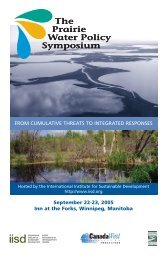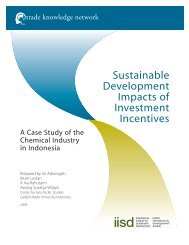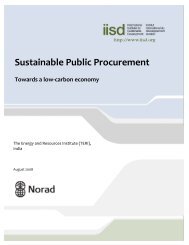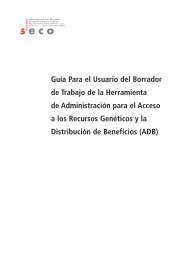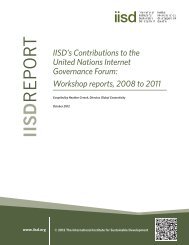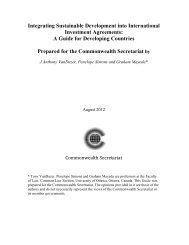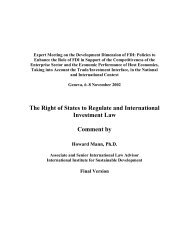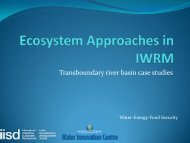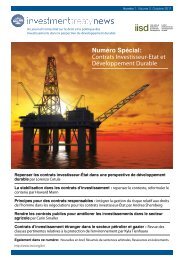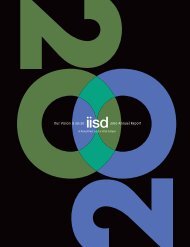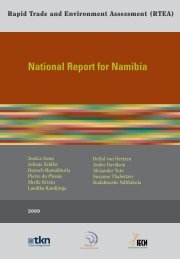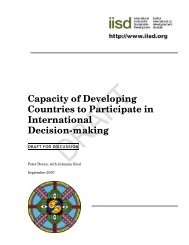2006/2007 Annual Report - International Institute for Sustainable ...
2006/2007 Annual Report - International Institute for Sustainable ...
2006/2007 Annual Report - International Institute for Sustainable ...
You also want an ePaper? Increase the reach of your titles
YUMPU automatically turns print PDFs into web optimized ePapers that Google loves.
“There is an incredible opportunity to address environmental impacts<br />
through the preservation and restoration of natural capital on the landscape,”<br />
NATURAL CAPITAL<br />
While governance plays a large role in IISD’s Lake<br />
Winnipeg work, other SNRM team members are exploring<br />
how ecosystems can be harnessed to reduce pollution<br />
within the Lake Winnipeg Watershed.<br />
Vivek Voora, Project Officer with SNRM, is working on the<br />
Natural Capital Approach.<br />
Natural capital refers to the natural environment, and the<br />
goods and services they provide, such as climate<br />
regulation, water filtration and soil renewal, to name a few.<br />
The multi-year study <strong>for</strong> Environment Canada will<br />
quantify and determine the value that ecosystems in the<br />
Manitoba portion of the Lake Winnipeg Watershed provide.<br />
“By identifying the natural capital of the landscape, we can<br />
quantify the benefits received from healthy and<br />
functioning ecosystems that are essential <strong>for</strong> mitigating<br />
nutrient flows into water bodies,” he explains.<br />
As Voora’s research progresses, he will work on landscape<br />
modelling, a process he hopes will reveal the best mix of<br />
natural and human-altered landcover to maximize the<br />
removal of nutrients from the watershed.<br />
“There is an incredible opportunity to address<br />
environmental impacts through the preservation and<br />
restoration of natural capital on the landscape,” he says.<br />
NUTRIENT SINKS AND BIOENERGY<br />
Wetlands are one of several ecosystems within the Lake<br />
Winnipeg Watershed with nutrient uptake potential.<br />
As the Director of SNRM, Henry David Venema is<br />
coordinating the cutting-edge wetlands research of PhD<br />
student and IISD Project Officer Richard Grosshans.<br />
With funding from IISD and the Natural Sciences and<br />
Engineering Research Council of Canada (NSERC),<br />
Grosshans’ work involves evaluating the ability of certain<br />
wetlands plants—particularly cattails, bulrushes, reeds and<br />
sedges—to absorb excess nutrients.<br />
Grosshans is working in the Netley-Libau Marsh just north<br />
of Winnipeg, a wetland that has been significantly<br />
degraded over time from dams and dredging.<br />
However, its strategic location along the path of the<br />
nutrient-rich Red River could prove useful.<br />
Venema says if the marsh can be suitably restored with the<br />
help of ecological engineering—a process that could<br />
involve building up the landscape and monitoring<br />
flooding through a series of dikes and hydraulics—it could<br />
be a very successful nutrient sink.<br />
But it will require regular “harvesting,” or cutting back<br />
vegetation, so plants can renew their nutrient uptake.<br />
“The nutrient sink potential provides a real economic<br />
benefit,” Venema explains.<br />
But it’s not the only economic spinoff.<br />
Venema believes the marsh harvest could be used to<br />
produce bioenergy that has the potential to be carbon<br />
neutral. For one, unlike canola, marshes are self fertilizing;<br />
they don’t require fertilizers or energy to grow. Second,<br />
they have the potential to offset fossil fuel use. Third, they<br />
provide a needed ecological service as a nutrient sink.<br />
“Rather than causing more environmental problems, using<br />
resource-intensive methods to produce bioenergy, we’re<br />
fixing an existing nutrient overload problem passively<br />
without further input,” he says.<br />
But he cautions that the nutrient sink can only remain<br />
active if it’s managed carefully; which brings SNRM’s<br />
research back to governance and integrated water resource<br />
management.<br />
For Venema, his role as Director is to ensure the high<br />
policy principles of sustainable development are at work in<br />
each research project.<br />
“An institute like ours—pro-internationally—needs to<br />
demonstrate how these high policy principles manifest in<br />
real practical examples” like the iconic and threatened lake<br />
in Manitoba’s own backyard, he says.<br />
With the Manitoba provincial government’s renewed<br />
mandate and their emphasis on cleaning up Lake<br />
Winnipeg, Venema is confident his research team will<br />
develop the ecosystem and economic instruments to help.<br />
“We have some extremely solid ideas that will contribute<br />
directly to this key policy area,” he says.<br />
Michelle French is IISD’s Publishing Officer.<br />
Algae in Lake Winnipeg, a body of water<br />
suffering from acute environmental stress.<br />
Photo courtesy of Lori Volkart.<br />
“An institute like ours…<br />
needs to demonstrate how<br />
these high policy principles<br />
manifest in real practical<br />
examples.”<br />
17



